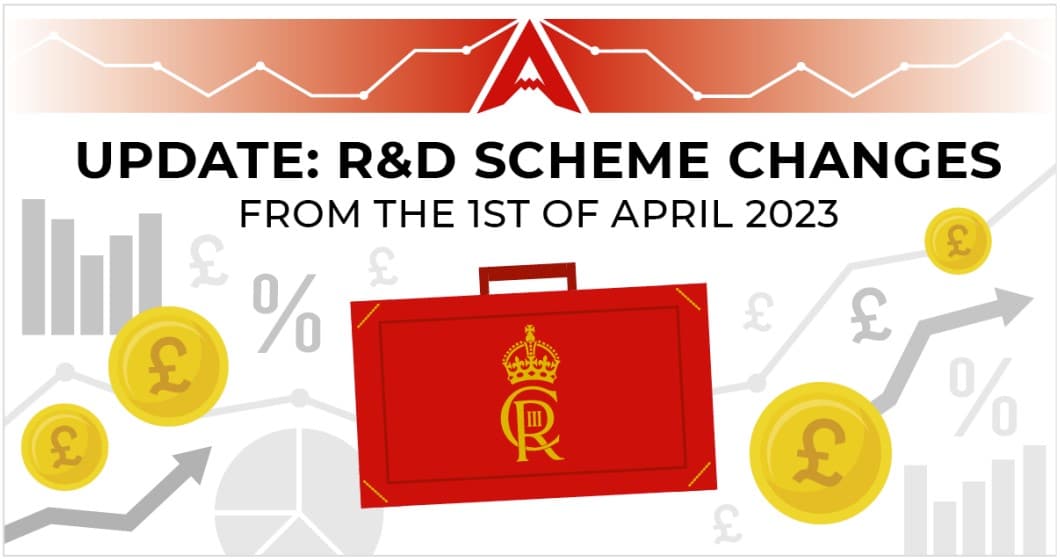
Update: R&D scheme changes from the 1st of April 2023
There’s been a lot of talk about changes to the R&D tax credit scheme over the past few months, both in the media, from politicians and HMRC. Consultations, advice from the House of Lords, last minute alterations and pulled proposals.
It has been a turbulent time, but the changes have now been introduced, as of the 1st April 2023!
We want to cut through the noise to give you clear, accurate and up to date information on the changes, to make sure you have all the information you need on how the new R&D tax credit rules may affect your business.
A summary of changes
In this article, we will explain the following changes to the R&D scheme [1][2], which have now come into effect:
The net benefit
- Benefit ranges for SMEs, as a percentage of qualifying expenditure, have decreased from 18.85% – 33.35%, down to 8.6% – 26.97%
- R&D Expenditure Credit (RDEC) net benefit, as a percentage of qualifying expenditure, has increased from 10.53% to between 15% – 16.2%
The mechanism
- Qualifying Expenditure uplift rate for the SME scheme has reduced from 130% to 86%
- SME tax credit rate decreased from 14.5% to 10%
- New credit rate of 14.5% for R&D intensive lossmaking SMEs (who spend at least 40% of their costs on R&D)
- RDEC credit rate has increased from 13% to 20%
Administrative changes
- Companies with accounting periods starting after 1 April 2023 must notify HMRC 6 months after their year end of their intent to claim R&D relief
- All R&D applications must now be made electronically and supported by additional information substantiating the claim. From 1 August 2023, companies must complete a digital additional information form detailing the R&D activity and a breakdown of the expenditure claimed
- Companies must disclose whether they used an R&D agent to assist with the claim, and the details of which agent if so
- All claims must be signed off by a senior member of the business
For those who prefer numbers, we have produced the table below to give a summary of how these new rates affect businesses.

The following assumptions have been made in the table above:
Profitable businesses with profits under £50,000 will pay Corporation Tax at 19% Corporation Tax, whilst businesses with profits over £250,000 will pay Corporation Tax 25%
The above table assumes lossmaking SME businesses surrender their losses for a payable tax credit
Qualifying R&D expenditure constitutes at least 40% of total expenditure for the R&D intensive businesses
Find out more about each of these changes and their implications below.
Previously announced SME uplift rate changes
In the Autumn Statement 2022, the government announced plans to adjust the SME incentive to reduce the rate for additional taxable deduction from 130% to 86%[3].
These changes have now been implemented and will affect any R&D expenditure incurred on or after the 1st of April 2023.
The impact of these changes, alongside the changes to the credit rate (more on that in the section below) is an overall decrease in the benefit delivered by the SME scheme, with the range of benefits decreasing from 18.85% – 33.35% of qualifying expenditure, down to 8.6% – 26.97%.
Where a company sits in this range will depend on their tax position (how profitable or lossmaking they are) and what percentage of their costs are associated with R&D.
New credit rate for lossmaking SMEs
The new credit rate of 10% (down from 14.5%) for lossmaking SMEs announced in the Autumn Statement has been introduced [4].
This will effectively reduce the maximum benefit (the percentage of qualifying expenditure the company gets back) from 33.35% of qualifying expenditure down to 18.6%, with exceptions made for “R&D intensive” SMEs that are detailed below.
It has a significant impact on breakeven businesses who opt to surrender their loss for a cash credit, reducing the benefit from 18.85% of qualifying expenditure to 8.6%.
New R&D rate changes for lossmaking SMEs
There were some last-minute changes announced to the rates of recovery that will impact lossmaking “R&D intensive” SMEs[5]. This is a new concept introduced by HMRC that is based on the percentage of a company’s total costs that are associated with R&D.
HMRC are defining “R&D intensive SMEs” as businesses that spend 40% or more of their total expenditure on qualifying R&D expenditure.
Businesses that fall under this category will be able to claim a higher payable credit rate of 14.5% for qualifying expenditure rather than the new 10% credit rate for other lossmaking SMEs.
Put simply, the new maximum benefit for these “R&D intensive” lossmaking SMEs will be 27% of their qualifying expenditure figure.

These changes came into effect for expenditure incurred on or after the 1st of April 2023.
Impact of new Corporation Tax rates
As confirmed in the Autumn Statement 2022[6], Corporation Tax increases have been brought into play, which (alongside the reduction in the uplift rate) directly impacts how the benefit affects profitable businesses.
This will now see companies with over £250,000 in profits paying Corporation Tax at a rate of 25%, while companies with profits under £50,000 will remain at 19%. Companies with profits between £50,000 – £250,000 will fall under a tapered rate between 19% – 25%.
What does this mean for businesses?

For an SME company earning less than £50,000 in profit, and therefore paying 19% Corporation Tax, that is receiving the benefit as a reduction in Corporation Tax, the rate of recovery will be 16.34%.
SMEs with profits over £250,000, and therefore paying 25% Corporation Tax, will see a rate of recovery of 21.5%.
Those SMEs under the tapered rate will receive between 16.34% – 21.5% depending on where they sit on this scale.
For any businesses applying for tax credits under RDEC, however, the benefit will range from 15% – 16.2% depending on the Corporation Tax rate the business pays. Businesses paying a higher rate of Corporation Tax will see a smaller benefit due to the taxable nature of the RDEC benefit.
R&D rate increases for RDEC
The RDEC rates have increased from 13% to 20%[7]. This change also came into effect for expenditure incurred on or 1st April 2023.

This will be a welcome change to many businesses and will positively impact large companies, SME subsidiaries of large companies/groups, and SMEs that have received grant funding for R&D projects.
The government will also benefit, with this change elevating the UK’s R&D tax relief to become the joint highest uncapped rate within the G7[8].
The RDEC scheme has long needed a boost, and it is great to see this need has finally been met.
Overseas expenditure restrictions delayed
Plans for overseas subcontractor costs to be predominantly disallowed under the SME scheme have now been pushed back a year and is set to come into force in April 2024 instead[9].
What does this mean?
To recap, the government previously announced plans to greatly restrict the eligibility of overseas subcontractor costs, currently allowable under the SME scheme, effectively making overseas subcontractor costs ineligible to recover in most situations. The intent behind this change was to increase innovation and trade within the UK.
This would have meant that SMEs who currently subcontract innovation work overseas would be unable to recover the costs (with a few exceptions), limiting them to subcontracting work within the UK.
Initially, this change was proposed to come into force in April 2023, which would have been a considerable worry for many UK businesses with multi-year contracts. Fortunately, the introduction of this change has been delayed for another year, currently set to be introduced in April 2024.
What next?
Before April 2024, the government will consider how these restrictions may work alongside a potential merged R&D relief structure (more on that later).
Administrative changes
Several reforms within HMRC have been introduced following their proposal in the Autumn Statement last November (click here for more information on this).
These include:
- Requirements for digital submission of R&D claims
- Endorsement of R&D claims by a senior officer of the company
- Mandatory submission of supporting information to substantiate claims, including breakdown of expenditure.
- Requirement of notification of the intention to submit a claim with HMRC.
- Submission of details of any agent supporting with the claim
How will this work?
From 1 August 2023, the supporting information will need to be provided through an additional information form, which will be submitted digitally alongside the R&D application. This will set require additional detail on both the R&D activity and the associated expenditure, alongside contact details for the senior officer responsible for the R&D claim and any agent assisting with the application.
Whilst much of this information is already provided in R&D reports currently prepared, HMRC have stated that supplementary R&D reports can still be provided and can be useful to include additional information not requested on the form e.g. details of the competent professionals.
These reforms aim to target abuse of the R&D schemes and improve compliance. Specifically, HMRC state the changes will make it easier for them to prevent fraudulent claims and stop spurious R&D agents from operating in the space.
More on the potential merge of R&D relief schemes
In the Autumn Statement, the Chancellor announced the potential merge the SME scheme with the RDEC scheme[10], to create one unified R&D tax credit scheme for all businesses. He cited a wish to ensure taxpayers’ money is being spent as effectively as possible, whilst simplifying the R&D tax credit process.
The government ran a consultation period for the proposition to merge RDEC and SME schemes between 13 January and 13 March. Apogee took part in this consultation to ensure our thoughts on how to improve the R&D scheme were heard and taken into account on our clients’ behalf.
What next?
The government is now considering the responses, and though no decision has been made just yet, a draft legislation is due to be published alongside the draft Finance Bill in the summer, along with a summary of responses submitted during the consultation period.
Summary
We’ve covered a lot in this article, so here’s a brief summary of each point discussed.
SME rate changes: The rate for additional taxable deduction (the uplift) has decreased from 130% to 86%.
Corporation Tax rates: Corporation Tax rates are now at 25% for companies with over £250,000 in profits; 19% for companies with profits under £50,000; and a new tapered rate of 19-25% for those with profits between £50,000 and £250,000.
R&D rates for lossmaking SMEs: The credit rate for lossmaking SMEs has been reduced from 14.5% to 10%. However, R&D intensive lossmaking SMEs can still claim a credit rate of 14.5%.
Rate increases for RDEC: RDEC rates have increased from 13% to 20%.
Overseas expenditure restrictions: Plans have been pushed back to April 2024, with no changes confirmed yet.
Administrative changes: Companies will now need to inform HMRC of intent to claim; R&D claims must be submitted digitally with endorsement from a senior member of the company; supporting information and details of agents assisting with the application must be provided.
Potential merge of R&D relief schemes: The government is considering responses from the two-month consultation period. We expect a decision to be announced in the summer.
We will of course update you on these situations when the government announces further information.
As your trusted R&D partner, Apogee’s focus is on providing you with the greatest benefit (net of fee) in the industry, paired with unmatched customer service.
Our team of experts are here to help you at every stage. If you have any questions or concerns about what we’ve covered in this month’s update, please do not hesitate to get in touch!
[1] AUTUMN STATEMENT 2022 (publishing.service.gov.uk) Paragraph 5.52
[2] Spring Budget 2023 (publishing.service.gov.uk) Paragraph 4.51
[3] AUTUMN STATEMENT 2022 (publishing.service.gov.uk) Paragraph 5.52
[4] AUTUMN STATEMENT 2022 (publishing.service.gov.uk) Paragraph 5.52
[5] Spring Budget 2023 (publishing.service.gov.uk) Paragraph 4.51
[6] AUTUMN STATEMENT 2022 (publishing.service.gov.uk) Paragraph 2.5
[7] AUTUMN STATEMENT 2022 (publishing.service.gov.uk) Paragraph 5.52
[8] Spring Budget 2023 (publishing.service.gov.uk) Paragraph 3.74
[9] Spring Budget 2023 (publishing.service.gov.uk) Paragraph 4.53
[10] AUTUMN STATEMENT 2022 (publishing.service.gov.uk) Paragraph 5.52


